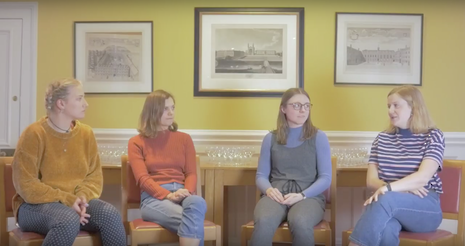The Cambridge Climate review: ‘investigating the University’s environmental impact’
Director and producer Bea Goddard chats to Rachel Tsang at the launch of her documentary

“I know I should do something for the environment, but I don’t know what.” These casual words spoken in Fresher’s Week sparked a thought in Bea Goddard. Why not make a short video showing some easy ways to become more environmentally aware, and introducing the basic systems already in place within the University?
But it quickly became clear that there was a much greater story to be told. Two central prongs of enquiry emerged: firstly, the stunning amount of waste generated at may balls, and secondly, the rapidly developing story of divestment. These two themes have troubled Bea from her first few weeks at Cambridge, but among the general student populace, the issue of divestment has since reached a fever pitch, and the unsustainability of may balls – following another heady May Week – is more pertinent than ever.
The Cambridge Climate, the fruit of months of careful investigation, therefore lands on our screens at the perfect moment. In conversation with students, societies, lecturers and University staff, Bea Goddard and her team take us from the worst may ball offenders, to the highly positive steps that have already been taken towards minimising our carbon footprint at other events. We learn of the University-wide initiatives that mark a growing environmental awareness, but also the ingrained collegiate structures that frustrate these impulses towards change. In this way, the film manifests a very welcome level-headedness – a reasoned voice that, as Goddard says, strives to “give credit where credit’s due, and criticise where criticism needs to be delivered.”
Despite the blow of the University’s refusal to fully divest coming right before the film’s launch (a shake of the head at our interview was about all the comment I got from Goddard), it is an ultimately positive message that The Cambridge Climate seeks to advance.
Beyond the genuinely useful practical tips offered up by interviewees, though, it is perhaps the very examples that they themselves provide that is most inspiring. Goddard tells me of an illuminating behind-the-scenes gaffe: upon arriving at their interview with Hugh Hunt, a lecturer in Engineering Dynamics and Vibration, the team discovered they’d forgotten to fully charge their camera’s batteries. Step in Dr Hunt, offering a self-made contraption to help power the camera. The realisation that there are so many dedicated to this cause, and willing to help out in whatever way they can, is one of the most heartening facets of the film.
And there is perhaps no greater example of this willingness to engage ecologically than the very production itself. Bea, who has long been interested in both filmmaking and environmental activism, found in documentary film a superb outlet with which to combine the two. Keeping up with the constantly evolving narrative, and becoming “a part of the conversation”, was a challenge met with a wholehearted enthusiasm. When I ask Bea if she sees herself making more movies anytime soon, she replies there is no reason why she wouldn’t. As she puts it, there is little more thrilling, or more rewarding, than to find “something that needs to be talked about,” and saying to yourself, “let’s put it on the screen.”
 News / Cambridge academics stand out in King’s 2026 Honours List2 January 2026
News / Cambridge academics stand out in King’s 2026 Honours List2 January 2026 Interviews / You don’t need to peak at Cambridge, says Robin Harding31 December 2025
Interviews / You don’t need to peak at Cambridge, says Robin Harding31 December 2025 Comment / What happened to men at Cambridge?31 December 2025
Comment / What happened to men at Cambridge?31 December 2025 News / Varsity’s biggest stories of 202531 December 2025
News / Varsity’s biggest stories of 202531 December 2025 Features / “It’s a momentary expression of rage”: reforming democracy from Cambridge4 January 2026
Features / “It’s a momentary expression of rage”: reforming democracy from Cambridge4 January 2026










